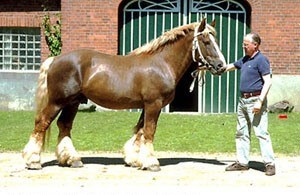Schleswig (also known as Schleswiger Heavy Draft, or Schleswiger
Kaltblut) horses are from the Duchy of Schleswig, Germany. They are thought to
be the origin of the Schleseiger Draft Horse along with the Jutland Heavy Draft
Horse. Although not a certainty, the Schleswiger Heavy Draft's ancestors not
only worked in agriculture tilling and pulling, but the Schleswigers probably
descended from the large war horses of the Middle Ages.
In 1860 an imported English stallion, Oppenheim LXII, either
a pure-bred or a part-bred Suffolk Punch, was introduced, and became the foundation
stallion of the breed. In 1888 the breeding of warmbloods and coldbloods was
separated, and in 1891 various associations of coldblood breeders in Schleswig
were brought together in the Verband der Schleswiger Pferdezuchtvereine, and
systematic breeding began. The brand V.S.P in an oval on the off hindleg was
chosen to identify registered horses and is still used today.
In 1893 the stallion Aldrup Munkedal 839 was born, a son of
Munkedal II 585 and a descendant of Oppenheim LXII; he won the king's prize at
the Jubilee celebrations in Odense in 1900, and 70,000 crowns were offered for
him. Ater the First World War all Schleswig Coldbloods descended from this
stallion.
By 1910 the Verband recorded 12,000 breeding animals.
Through regional agricultural shows, the Schleswig Coldblood became widely
known and was sold throughout Germany. Schleswig was divided between Denmark
and Germany in 1920, as part of the aftermath of the First World War. That meant
the loss of a large part of the breeding area for these horses and was a major
setback. However numbers rose again, and in 1949 reached a peak of about 450
stallions and around 25,000 brood mares in the hands of more than 15,000
breeders spread throughout Schleswig-Holstein. In 1958 two French stallions
were added to the breeding stock.
In the years following the Second World War the
mechanisation of agriculture, with the replacement of agricultural horses with
tractors, led to a dramatic decline in numbers. By 1976 they had fallen to a
low of 35 mares and 5 stallions, and in that year the old society was dissolved
and the remaining animals were registered in the Schleswig-Holstein horse
register in Kiel. A society for the protection of S chleswig horses was soon
formed, and in 1991 this became the Verein Schleswiger Pferdezüchter, or
Schleswig horse breeders' association.
Since 1997 numbers have remained stable at about 200–250; in
2013 there were 189 mares and 26 stallions. The Schleswig Coldblood was listed
as endangered by the Food and Agriculture Organisation (FAO) of the United
Nations in 2007. In 2013 it was in Category II: seriously endangered on the
Rote Liste of the Gesellschaft zur Erhaltung alter und gefahrdeter
Haustierrassen, the German national association for the conservation of
historic and endangered domestic animal breeds, and was listed as minimally
endangered by the European Association for Animal Production (EAAP).
Since 2012 a sub-population, the Hannoversches Kaltblut
Schleswiger Ursprungs, or roughly "Hanoverian coldblood of Schleswig
origin", has been included in the Schleswiger Coldblood breed; in 2012
there were a total of 62, 4 stallions and 58 mares.
Schleswig Horses stand approximately 154 (5 feet 1 inch or
61 inches) - 162 cm(5 feet 4 inches or 65 inches) or 15.2 to 16 hands. The
stallions are on average, bigger than the mares. Their legs are strong and dry,
lightly feathered. The round hooves are of good quality. The back should be
short and well muscled; however, many have backs that are longer than most
draft horses. They have deep chests. The head is short and straight with a
broad forehead. The neck should be well proportioned. The Schleswiger is
usually chestnut colored, although black, grey and bay occur. The Schleswiger
is an excellent mover with an astounding walk and trot. The Schleswiger has a
good placid character and is very willing to learn. They are versatile, agile
and of great endurance, and are easy to keep. Feeding problems are virtually
unknown to this breed.
They are used for farming and other agricultural endeavors.
Hauling loads such as timber, pulling omnibuses, in the brewery business, in
nurseries, and for military purposes. They are also used for pleasure.
